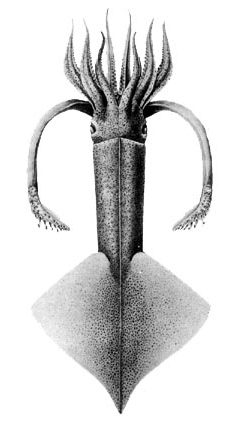| Onychoteuthis | |
|---|---|
 | |
| Onychoteuthis banksii | |
| Scientific classification | |
| Kingdom: | Animalia |
| Phylum: | Mollusca |
| Class: | Cephalopoda |
| Order: | Oegopsida |
| Family: | Onychoteuthidae |
| Genus: | Onychoteuthis Lichtenstein, 1818 [1] |
| Type species | |
| Onychoteuthis bergii Lichtenstein, 1818 | |
| Species | |
See text | |
| Synonyms | |
Onychoteuthis is a genus of squid in the family Onychoteuthidae. The type species is Onychoteuthis bergii . While the genus is found worldwide in tropical and subtropical oceans, they can also occur in the North Pacific Ocean. There were previously considered to be four species in the genus but there are now considered to be roughly 10. These squid are frequently observed in the surface waters at night and they are often caught using dipnet at nightlight stations. The young squid are usually the only specimens captured using standard midwater trawls, the older squid are apparently able to avoid the trawls. They can, however be collected from the air as individuals are able to leap high out of the water, sometimes even landing on the deck of a ship. [2]
